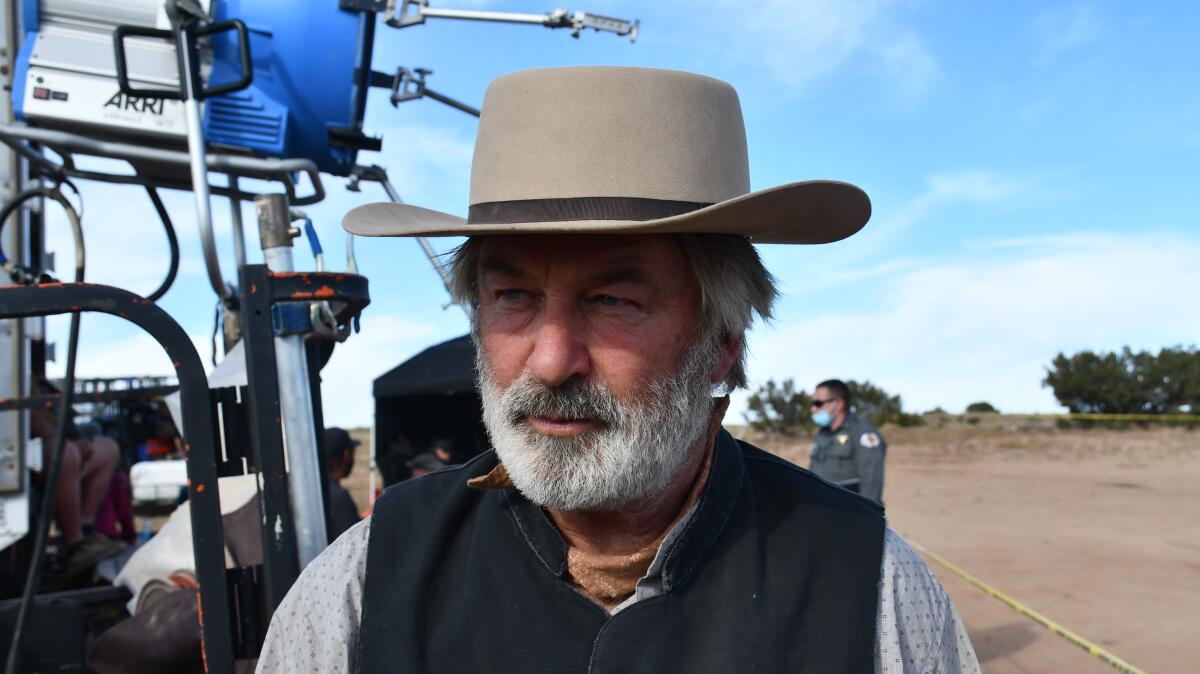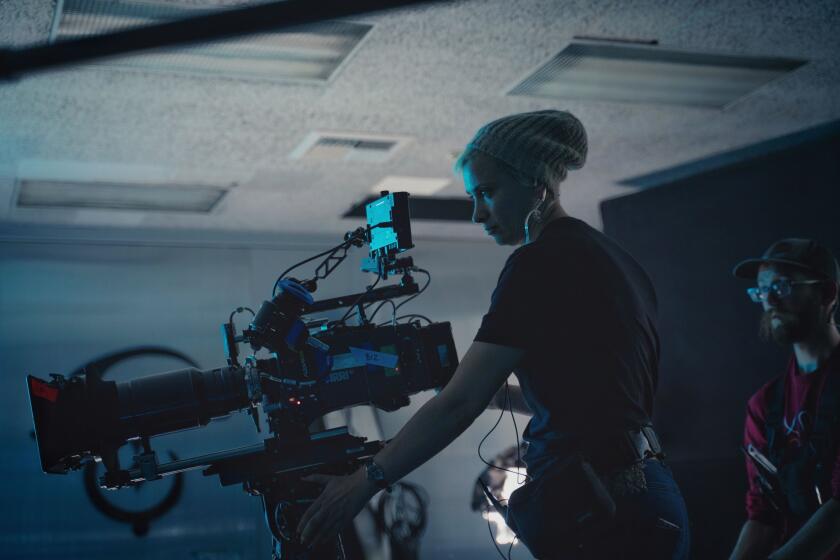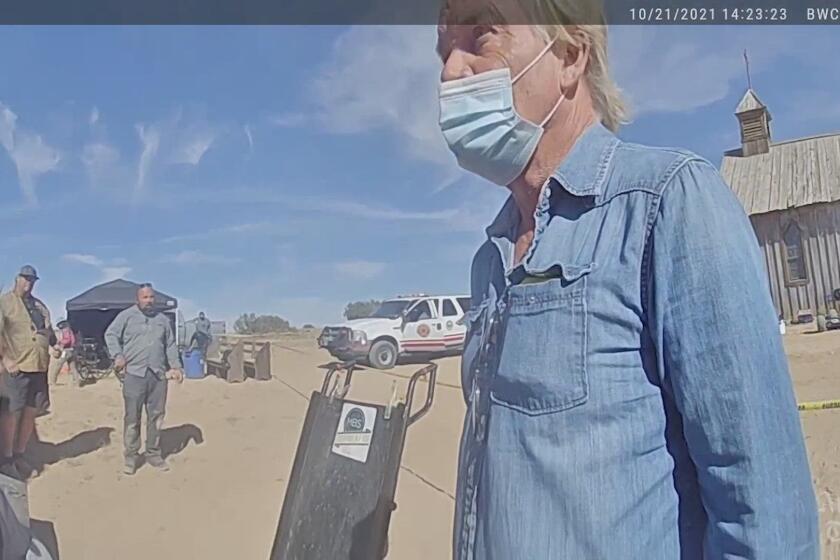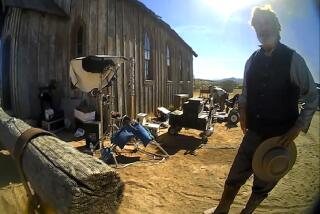Column: Halyna Hutchins’ final moments should not be offered for public consumption

On Monday afternoon, the Santa Fe County Sheriff’s Office released a Dropbox filled with documents and video evidence from the ongoing investigation into the fatal shooting of cinematographer Halyna Hutchins, and wounding of director Joel Souza, on the set of the Alec Baldwin film “Rust” last year.
Included in the remarkably large information dump were scenes of Baldwin rehearsing what would become the fatal shot; officers’ body camera recordings of Baldwin, crew members and law enforcement as early responders attempt to contain the scene; and police interviews with, among others, Baldwin, Souza (one as he receives treatment in the emergency room), armorer Hannah Gutierrez Reed and weapons provider Seth Kenney.
It also included images of emergency crew members attempting to treat Hutchins and many photographs of the police scene, including bloody footprints and pieces of blood-soaked gauze.
What wasn’t included was any new information about how a lead bullet got into the gun Baldwin held, why the gun fired though he claimed he did not pull the trigger or who brought the many rounds of live ammunition to the set in direct contradiction with production protocols.
Cinematographer Halyna Hutchins was killed on the set of “Rust” in October 2021. A judge dismissed the involuntary manslaughter case against star Alec Baldwin in July 2024.
Also missing was any sense that the district attorney was any closer to deciding if charges would be filed against anyone involved.
So an information dump with little or no new information. If anything, it felt like an enormous distraction from the actual investigation. But there was blood, actual and emotional.
As media outlets around the world scrambled to sift through the unredacted, unorganized welter of material, some chose to use discretion, but others did not; within hours of the dump, the images of Hutchins’ final moments could be found all over the internet, along with the less disturbing but still invasive footage of Baldwin, Gutierrez Reed and others reacting to the shocking event.
Everything in the Dropbox file was, of course, what actually happened, and as a journalist, I can stand only on the side of transparency. But as a journalist, I also know that there are many details and images that add less to the illumination of a story and more to its sensationalism. Which, in turn, often distracts from the actual story while causing unnecessary harm to individuals.
Individuals including Hutchins’ husband and young son, forced to share a personally cataclysmic image with the rest of the world, or the countless crew members reliving one of the worst days of their lives. Having chosen to work behind the scenes, they are, as the videos circulate, now unwitting stars of a ghastly reality show.
New Mexico has very liberal disclosure laws, although there are exceptions, including for ongoing investigations. According to the sheriff’s department, the massive release was a response to continued requests for documents relating to the case. According to a spokesperson, the department was in compliance not only with the state’s Inspection of Public Records Act, but also the state’s victim’s rights laws, which require that victims be treated with fairness, dignity and privacy throughout the criminal justice process.
After the release, however, Brian Panish, the lawyer for the Hutchins family, said in a statement: “We were surprised by the decision of the Santa Fe County Sheriff’s Office to release such a large amount of evidence given that the investigation is still ongoing and active. For this reason, we are not going to comment on the material released except to say we hope the press will exercise discretion in how they use the graphic images and videos of the fatal events of Oct 21, 2021.”
It should be noted that the number of users attempting to access the material caused the Dropbox file to crash shortly after it went out.
Whether in compliance or not, this is absolutely not the way evidence in an ongoing criminal investigation is normally dispersed to the media, or in this case to whoever had the link to the Dropbox.
In its volume and its lack of editing and redaction, the information dump is difficult not to see as something more than disclosure. Was it an act of aggression toward the national press — you want the information? Here’s aaaalllll the information. An attempt to force the DA to pick up her feet? Or simply the relatively small sheriff’s department throwing up its hands? In any case, the result was the same: the dispersal of images, including those of a woman dying, that should have been redacted and a general feeling that it was somehow up to the press, and the public, to figure out what happened on that terrible day.
What the Santa Fe County Sheriff’s Office made available was not so much information as a challenge to play a morbid, deeply disturbing game of “Clue.”
The worst aspect of the dump was, obviously, the images of Hutchins. But given the involvement of Baldwin, the very public nature of the case and, well, the internet, there is also the issue of context. Releasing, pell-mell, video of people’s initial reactions to the shooting invites precisely the kind of arm-chair psychology social media loves. Is Baldwin or Gutierrez Reed upset enough? Worried enough? Upset and worried about the right things in the right way?
The family of the cinematographer Halyna Hutchins, who was killed by Alec Baldwin on the ‘Rust’ set, urged caution in the use of video footage.
And what does that say in terms of responsibility? Hutchins’ husband, Matthew, has said one of the reasons he included Baldwin in the wrongful-death lawsuit he filed against the producers of “Rust” was that the actor was so quick to publicly distance himself from any responsibility. That was Baldwin’s choice, but it seems impossible that this footage will not have a similar effect in the court of public opinion.
An argument could be made that it is up to the media to use discretion to avoid such things, and that is fair but stickier. The startling release of so much information is, in itself, news, and for outlets, like The Times, that have been rigorously covering the “Rust” story, the details provided by the new documents and video are impossible to ignore entirely, particularly because the story has so much significance even beyond its specific tragedy.
That significance, however, is not about personality but protocol.
Hutchins’ death was entirely preventable. The film industry has strict multitiered protocols regarding the handling of weapons and ammunition on film sets; for reasons of economy, scheduling or oversight by more than one person, those protocols were not followed on the set of “Rust,” with terrible consequences.
Law enforcement too has protocols when dispersing information to the public, which include a duty to care for those involved in any investigation. Drowning the media with a deluge of images and details provides care to no one.
With all the evidence it has, the Santa Fe County Sheriff’s Office seems to have missed the key to the whole case: Protocols exist for a reason.
More to Read
The biggest entertainment stories
Get our big stories about Hollywood, film, television, music, arts, culture and more right in your inbox as soon as they publish.
You may occasionally receive promotional content from the Los Angeles Times.













